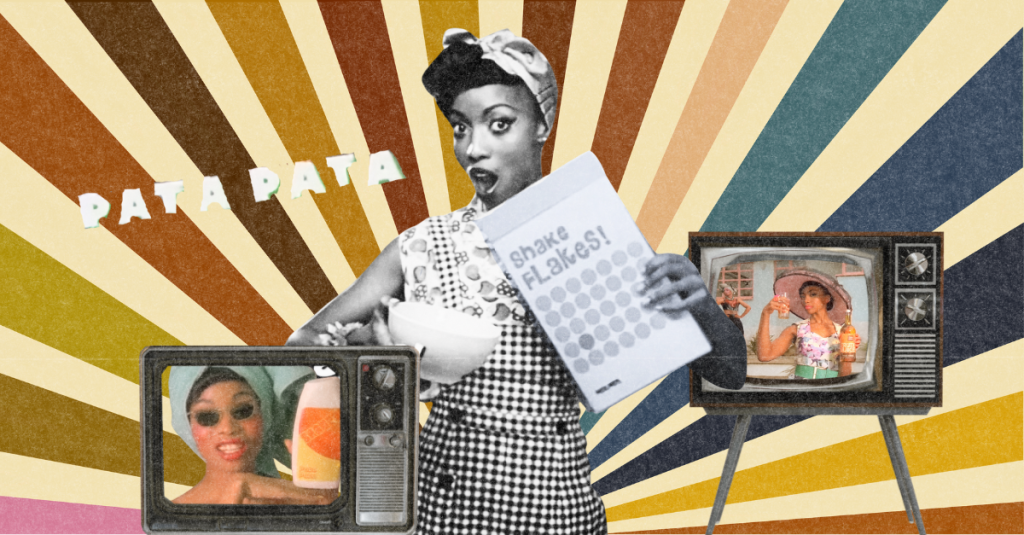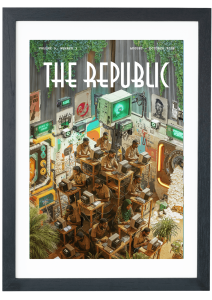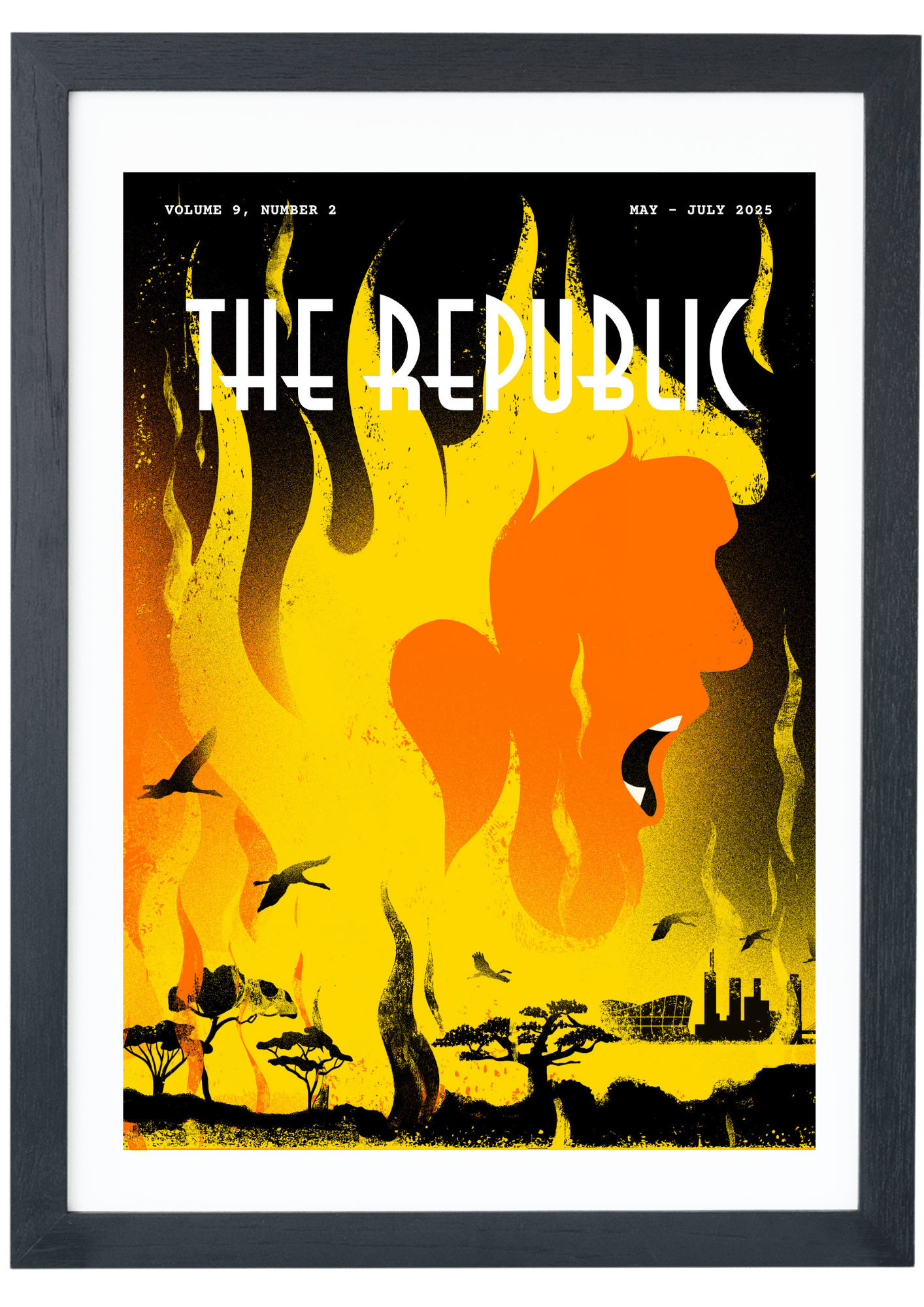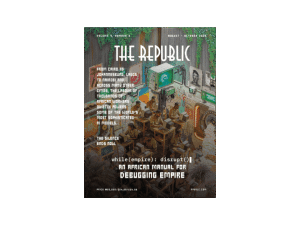
Photo Illustration by Ezinne Osueke / THE REPUBLIC. Source Ref: Temi Dollface/ YOUTUBE.
THE MINISTRY OF ARTS / MUSIC DEPT.
What Happened to Temi Dollface?

Photo Illustration by Ezinne Osueke / THE REPUBLIC. Source Ref: Temi Dollface/ YOUTUBE.
THE MINISTRY OF ARTS / MUSIC DEPT.
What Happened to Temi Dollface?
Temitope Phil-Ebosie, popularly known as Temi Dollface, released her debut single, ‘Pata Pata’, well past the ‘prime’ active years for emerging artists in Nigeria, especially for women. Her active years (2011–2017) were nestled in the wilderness years after the Afropop renaissance of the late 1990s and early 2000s and before the Afrobeats Rising wave of the late 2010s and early 2020s. Temi Dollface had no contemporaries, no connections to star-making vehicles like Nigerian Idol, Project Fame or X-Factor UK, and no easily digestible gimmick that could endear her to fans. Yet, in Temi Dollface’s hands, these disparate obstacles presented a unique opportunity to create music unmoored from the tropes of the zeitgeist. Few women have succeeded in the industry without minimizing their presence or compromising their artistic vision. Even fewer have earned mainstream success and the respect of their peers. Temi Dollface managed to do both in her brief but spectacular run with a compact body of work so inspired that it transcends the confines of convention and genre.
Temi Dollface’s impact and erasure begs the question: How does an independent female artist, making alternative music in an industry notoriously resistant to newness, manage to hold a whole generation of fans, artists and contemporaries in her thrall? Why does she leave when the applause is loudest? Why does her music continue to resonate in an industry controlled by fads and trends? And why is she rarely included in the canon of Nigeria’s most influential artists?
BORN IN THE RIGHT ERA: THE MYTH OF AN ARTIST BEFORE THEIR TIME
Understanding how an artist like Temi Dollface came to exist requires a little foray into Nigerian history. Nigeria’s return to democratic rule in 1999, with Olusegun Obasanjo was the climax of a fifteen-year violent and oppressive political cycle that started in 1983 with a bloodless coup. A consequence of that fifteen-year dictatorship sustained by state-sanctioned violence and oppression was mass flight, only rivalled by the civil war which started in 1967. Obasanjo, the new democratic president, gained an appreciation for the arts during his time as a political prisoner. He was keen on reviving the country’s creative economy and funded a massive campaign to convince Nigerian creatives and entrepreneurs to ‘return’ home.
It worked. A creative renaissance swept through Nigeria, and creatives returned in their droves. D’Banj, Don Jazzy and JJC Skillz, now legends in their own right, left the United Kingdom for Lagos. Bankole ‘Banky W’ Wellington, Jude ‘M.I’ Abaga and Lanre ‘El-Dee’ Dabiri returned from the United States after struggling to break into the very insular American music market. They leveraged the creative skills and business expertise they had gained to start the first indie labels in the country. They terraformed the once-dying industry and started exporting ‘Nigeria to the world’.
Temi Dollface was part of the second wave of returnees who followed in the wake of these pioneers. As a scion of the famed Adefarasin clerical dynasty (there are two generations of Adefarasins pastoring major churches in Nigeria), Temi Dollface was raised as a Pentecostal and surrounded by music in the church. During the three years her mother worshipped at his church, Chris Okotie—a former Nigerian rockstar turned megachurch pastor—gave her a Casio keyboard and a box of cassette tapes for her dictaphone, recognizing her musical inclinations. She went on to teach herself the piano and wrote her first song at age seven, with guidance from the children’s church teachers.
Temi Dollface lived with her grandmother for most of her teens before moving to the UK. During this time, she was discovered by Sony Music UK and signed artist development and publishing deals. She spent the next five years languishing in artist development hell while writing songs for other artists—an unfortunate brush with discrimination she shared with other young British female artists like Raye and Bebe Rexha. With encouragement from Tec and Ghost of Show Dem Camp, Temi Dollface returned to Nigeria after the expiration of her contract in 2012 to build a career as an independent artist.
On returning to Nigeria, Temi Dollface began the gruelling work of building a distinctive brand for herself. She took on a new stage name, coined by British street photographers who praised her eye for fashion and exotic features. It was the only external influence on her unwavering vision for her artistry.
ENTER TEMI DOLLFACE
Electronic music is integral to the evolution of Temi Dollface’s sound. In 2007, Apple launched GarageBand, the first mass-market production software that could be used with the Apple Mac. In 2008, the first version of FruityLoops (now known as FL Studio) was launched for the Windows operating system. Digital Audio Workstation (DAW) software allowed millions of young people to experiment with music production and produce groundbreaking, synth-heavy music. The music they created became what is known today as ‘bedroom pop’, a genre of electronic music that relied on mass-marketed production software and its distinctive synths and pre-loaded beats.
Temi Dollface was one of the first contemporary Nigerian artists to incorporate experimental digital production into her music. She learnt how to produce in real-time, using MIDI machines, cutting-edge synthesizers and voice-altering vocoders in her music. This allowed her to wear multiple skins, like cyborgs, altering her tone and timbre to populate the fantastical sonic universe in which the stories in her music unfolded.
As part of the UK’s thriving underground music scene, Temi Dollface’s music is influenced by the bedroom pop movement and the microgenres that evolved from it. In her slim but impactful discography, there are obvious hints of synthwave, folktronica, ambient pop and vaporwave. But she is also deeply entrenched in music from the continent, particularly the work of Fela Kuti, the legendary firebrand musician and activist whose proficiency with instruments and penchant for subversive activism she finds deeply inspiring. Her wildly imaginative interpretations of these influences mesh into a unique genre she calls ‘drama soul’.
shop the republic
A TIME-TRAVELLING TECHNOMANCING REBEL
It is impossible to discuss Temi Dollface’s short but revolutionary run in the Nigerian music industry without exploring the social commentary that permeates her work. Her artistry and body of work take on new meaning when viewed as an expression of Africanfuturism.
As a creative multitasker skilled in worldbuilding, Temi Dollface has discussed the influence of Africanism—a philosophy that centres African history, culture, religion and wisdom in contemporary conversations—in her work. Africanism has multiple expressions, but the most popular is Africanfuturism. Writer, Nnedi Okorafor, first coined the term to separate her work from Afrofuturism, a blanket term used to describe fantastical creative work that centres the Black American and African diasporic experience.
Following her return to Nigeria, Temi Dollface’s work became thematically focused on Africanism, embodying its principles through creative expression. While her contemporaries use electronic music as a vehicle to time-jump into Afrofuturist futures where racist tropes are eradicated or subverted, Temi’s Africanism-influenced Africanfuturism uses immersive and expansive worldbuilding to interrogate past injustices and comment on ongoing classism and bigotry. This experimental approach to creation permeates her style, visual language and aesthetics, and informs her artist persona, the vehicle that drives her storytelling. Temi Dollface draws inspiration from her mother, a classically trained visual and performance artist and an amateur archivist, whose curated archive of clothes and accessories from the 1950s to the 1980s becomes integral to her artist persona. Using these clothes as an anchor, along with her almost esoteric archive of obscure visual, textual and sonic references, Temi Dollface creates a retinue of expressive costumes that allow her to bring to life the principal character in the sonic universe she is creating, a time-travelling technomancing rebel who preaches the message of female liberation.
Temi Dollface’s first single, ‘Pata Pata’, is an excellent thesis statement on her artistic praxis. The song explores themes of romantic incompatibility from the perspective of a scorned housewife who tries to negotiate her way out of a romantic entanglement. This idea is further explored through visual motifs in her debut music video. This lurid, 1950s-inspired dreamscape uses the infomercial template popularized by television to satirize how capitalism offers escapism to exploit trauma. This vision is brought to life through her creative and artistic direction, as she conceptualizes the detailed sets and collaborates with director James Slater and stylist Alton to bring this alternative universe of east-meets-west Nigeria to life through clothing, set design, props and choreography.
Temi Dollface’s second single, ‘Just Like That (Story)’, is a scathing critique of the Nigerian middle class, mocking their contradictions and hypocrisy. She follows it with ‘School Your Face’, an empowerment anthem in which she encourages women to be militant about prioritizing self-actualization over romantic attraction. In the video, she features and pays loving homage to her grandmother Hilda Adefarasin, a former president of the National Council for Women Society, whose work as an early champion for women’s equity has influenced Temi Dollface’s politics. This song is connected to her sonic universe by recurring motifs, such as the ‘truth juice’ from the ‘Pata Pata’ video and her interpolations.
Her final single, ‘Beep Beep’, is her opus. Ambitious in scope and lavish in execution, the single and its rollout are the clearest expressions of her artistic vision. Temi Dollface reintroduces us to the scorned housewife from ‘Pata Pata’, now a newly single pin-up era vamp in the single’s accompanying music video. She is reborn as the sultry star of a 50s-style cabaret, surrounded by lavishly costumed dancers as she works an enraptured crowd in a dimly lit club named the Joy Division, a grim reference to the brothels established in German concentration camps during the Second World War. She commands the stage as she sings of her beauty, wit and sensuality. Each era-accurate costume is elaborate and executed with exquisite detail.
Temi Dollface’s musical and pop-culture references are vast, incorporating interpolations from Busta Rhymes and Drake and comparisons to Marilyn Monroe and Lynda Carter’s Wonder Woman. She embraces a big, brassy sound for the instrumentation, incorporating jazz standards and scat singing that hark back to musical greats like Billie Holiday and Dizzy Gillespie, while showcasing the vocal dexterity of her three-octave range. It is a creative triumph unlike anything the industry has ever witnessed.
AN ALTE PIONEER
While Temi Dollface is best known for her wildly imaginative music, her influence on the music industry, particularly Nigeria’s profoundly influential ‘alte movement’, is extensive. As one of the first female artists to achieve mainstream success without label influence, she offered a blueprint for independent music releases, complete with extensive press and marketing. Her debut music video for ‘Pata Pata’ soared to the top of the Sound City and TVC video charts, unheard of at the time for an independent artist. Temi Dollface cultivated an underground fandom with its distinct subculture and monetized her music through extensive collaborations across multiple industries; lessons that the Nigerian ‘alte’ movement, which began to gain traction in 2016, would draw from as they subverted the existing hierarchy.
Temi Dollface also distinguished herself as a marketing and business savant. She courted desirability and attained sex symbol status, achieving the rare recognition of being name-dropped in Falz’s ‘Celebrity Girlfriend’, alongside legends like Rita Dominic. She was fashion-forward, starting many trends and adopting the rich auntie aesthetic through her vintage store ‘Awe-Dacious’, long before it became fashionable during the 2020 pandemic.
Additionally, Temi Dollface had long-standing creative relationships with revered Nigerian rap duo, Show Dem Camp and music executive Chin Okeke, joining forces with them and producers Ikon Ekwuyasi and Kid Konnect to start the music collective, The Collectiv3. As part of The Collectiv3, Temi Dollface worked on two EPs, where she wrote, composed and co-produced with Ikon and Kid Konnect. She also worked closely with Show Dem Camp during their diversion from their concept-driven, purist rap arc of their Clone Wars mixtapes, into their second era of ‘Palmwine Music’. Released in 2017, Palmwine Music 1 follows The Collectiv3’s blueprint of unlikely collaborations and deeply experimental, multi-genre music. Temi Dollface even lent her voice acting talents to the duo’s now iconic tag, ‘You are now rocking with the SDC.’ That first Palmwine Music experiment has grown into a critically acclaimed multi-album project and an international festival, now in its eighth year, platforming many alternative artists.
Through her collaborations with Show Dem Camp and The Collectiv3, Temi Dollface is directly linked to rapper Ladi Poe, who went on to sign with Mavin Records and trigger a resurgence of interest in rap; singers Funbi and Preye Itams, who are R&B indie darlings; and Tems, who under the guidance of Wale Davies, or Tec from Show Dem Camp, has become a global superstar, winning multiple international awards, including two Grammy awards. It is not a stretch to say that Tec took a chance on Tems as an unconventional artist with a distinct viewpoint because he had seen what was possible through Temi Dollface.
shop the republic
A ONCE-IN-GENERATION PERFORMER
The music was already groundbreaking, but Temi Dollface found ways to bring this fantastical world and scathing social commentary into her performances. She adapted her sets to utilize the physical spaces where she performed, fine-tuning the experience until it was tone perfect. Two performances exhibit the true range of her skills as both composer and performer. The first is her Ndani Session from 2015, about a year into her debut. Using a Kaoss pad, a toy xylophone, maracas and a tambourine, she stacks vocals and instrumentation to build an eerie chorus as she performs a stripped-down version of ‘Pata Pata’. The second is one of her final recorded performances, a guest performance set during the 2016 Felabration festival. Dele Sosimi’s Afrobeat Orchestra was a headlining performer for the British leg of the festival, and hundreds packed into the Electric Ballroom in London. Like many tribute bands, Afrobeat Orchestra performed a broadly referential, instrument-heavy version of Afrobeats that relied more on technical skill and mimicry than experimentation and gravitas. That is, until Temi Dollface took the stage.
Using a vocoder, Temi Dollface distorts her voice into a baritone to mimic Fela’s raspy drawl. As though possessed, this woman with a blonde pixie cut and a 30-inch braided rat tail channels the great Fela’s swagger as she commandeers the crowd, leering and taunting as she sets the stage for her stories. She weaves classic Felaisms like ‘We are entering into another dimension’ and ‘I never tell you finish’, and the chorus of Femi Kuti’s ‘Wonder Wonder’ into her performance. The choice of interpolations is intentional and layered with meaning. During the performance, Temi Dollface raps and belts complex runs that go from a deep baritone to a breathy falsetto. She emotes almost effortlessly, switching her voice and digitally augmented chorus, summoning Fela as a scene partner as she mesmerizes the audience. These whimsical choices, executed with technical precision, set Temi Dollface apart from her contemporaries at the time.
This performance is significant in hindsight, for multiple reasons. Temi Dollface’s London performance is an encore of an earlier set performed in Lagos during the 2014 edition of the Felabration festival with similar but less audacious flourishes. To be invited on a bigger stage suggests that her genius was recognized by the Kuti family, long before the rest of the industry caught on. They bestowed on her the rare honour of revisiting the famed singer’s legacy with a song that continues his tradition of using popular music to champion social issues. It is the kind of recognition that artists like Wizkid and Burna Boy will fall over themselves years later to receive.
shop the republic
-
‘The Empire Hacks Back’ by Olalekan Jeyifous by Olalekan Jeyifous
₦70,000.00 – ₦75,000.00Price range: ₦70,000.00 through ₦75,000.00 This product has multiple variants. The options may be chosen on the product page -
‘Make the World Burn Again’ by Edel Rodriguez by Edel Rodriguez
₦70,000.00 – ₦75,000.00Price range: ₦70,000.00 through ₦75,000.00 This product has multiple variants. The options may be chosen on the product page -
‘Nigerian Theatre’ Print by Shalom Ojo
₦150,000.00 -
‘Natural Synthesis’ Print by Diana Ejaita
₦70,000.00 – ₦75,000.00Price range: ₦70,000.00 through ₦75,000.00 This product has multiple variants. The options may be chosen on the product page
shop the republic
WHEN THEY NEEDED HER THE MOST…
Temi Dollface’s disappearance from the industry was apocalyptic. One moment, she was on every red carpet as an alternative fashion icon, booking coveted mainstream performance gigs and disrupting the status quo with her imaginative and irreverent videos. The next, she was gone, a crescendo that preceded years of radio silence.
After her 2016 Felabration performance, the music and videos stopped. Social media updates slowed until her last personal Instagram post, published in 2017. This wasn’t uncommon for Temi Dollface, as she had only released four official singles in the three years she was active: three singles as a solo artist and one as part of The Collectiv3. She had dropped hints that she had been working on a debut solo album, so it was assumed she had retreated to complete that. But this absence became a source of worry when Temi Dollface’s slim catalogue never made it to Apple Music. The streaming platform was launched in Nigeria in 2015, allowing diasporic Africans to engage with music from Nigeria. Temi and The Collectiv3 seemed the perfect millennial ambassadors for the country’s underground scene. Before Apple Music’s entry, the mainstream musicians of Temi Dollface’s era relied on radio airplay to find new audiences, while underground artists turned to SoundCloud, a new-fangled streaming service favoured by underground ‘alte’ artists that wasn’t very strict about protecting intellectual property. YouTube, where she had uploaded most of her music and performance catalogue, was niche and costly, and Spotify wouldn’t begin operations in Nigeria until 2021.
The Nigerian ‘alte’ movement would take off in 2017, spurred by growing fandoms, and mainstream listeners in Nigeria would migrate to Apple Music, discouraged from using SoundCloud because of its insular and elitist communities, glitchy algorithm and complex user interface. It didn’t help that social media wasn’t as pervasive when Temi Dollface was active as it is today, and her brand relied on mystique and a minimal digital footprint. By 2018, Temi Dollface’s stellar four-single run was largely lost in the noise of Afrobeats rising, save for her SoundCloud profile, three music videos and a handful of performance videos revisited with something akin to reverence by nostalgic millennials. The internet never forgets and occasionally recognizes talent. Every other month, someone outside her original fanbase discovers some aspect of her craft, triggering a viral moment and the now-familiar refrain of ‘Where is Temi Dollface? What happened to her? Why did she stop making music?’
Speculation about her absence has grown increasingly fatalistic over the years, with the most recent iterations suggesting premature death or industry-related trauma so severe it forced her to make a clean break from the industry. These fears are not unfounded. The Nigerian music industry is hostile to women.
It is an uncomfortable truth that is skirted in discussions of why there is a dearth of successful female artists in the industry on every tier. Female artists are expected to attain impossible standards not required of their male contemporaries, endure unsolicited sexual attention and prioritize the performance of femininity over their careers or mental health. Temi Dollface retained 100 per cent ownership of her catalogue and total control over how her music is consumed, a rarity even in today’s more sophisticated industry. That kind of assertiveness, initiative and ambition are interpreted as signs that a woman cannot be controlled and will not conform, and in many cases, used as justification for humiliation or violence.
In 2023, seven years after her ‘disappearance’, Temi Dollface was spotted in a picture carousel posted to Instagram by Ifeanyi Adefarasin, mega pastor at House on the Rock. She stood in profile in a blush pink dress and a wine-coloured pixie cut under a gauzy blush pink canopy. News of her sighting spread on social media, alongside jokes about how it is very popstar of Temi to be spotted, paparazzi style, at a funeral, after an eight-year disappearance. The jokes inadvertently trivialize a seismic shift in Temi Dollface’s life as she grieves the passing of Hilda Adefarasin, her maternal grandmother and eternal muse. It is the curse of celebrity that even after years of away from the spotlight, fame eclipses humanity.
Beyond the jokes and half-hearted pleas about new music, the general sentiment is mostly relief, tinged with expectant hope. Women who shine so brightly and then disappear rarely get to do it of their own volition. Temi Dollface is safe, and I hope, aware that her work has become a touchstone of creative brilliance and originality in an industry often plagued with mind-numbing sameness⎈
BUY THE MAGAZINE AND/OR THE COVER
-
‘Make the World Burn Again’ by Edel Rodriguez by Edel Rodriguez
₦70,000.00 – ₦75,000.00Price range: ₦70,000.00 through ₦75,000.00 This product has multiple variants. The options may be chosen on the product page -
The Republic V9, N2 Who Dey Fear Donald Trump? / Africa In The Era Of Multipolarity
₦40,000.00
















